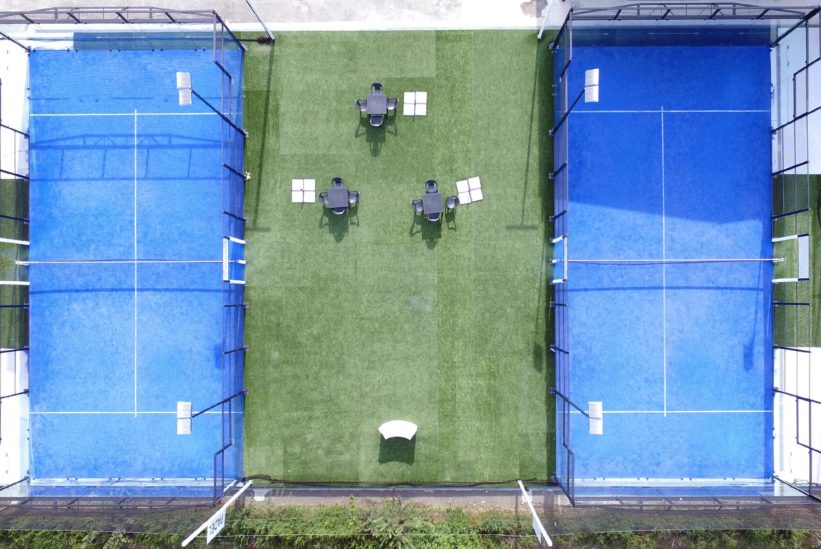(1) 2011 edition (A.U. n.1/2 January – February 2014)
INDEX
Foreword p. 2
Title I – The installation
A) – The courts ” 3
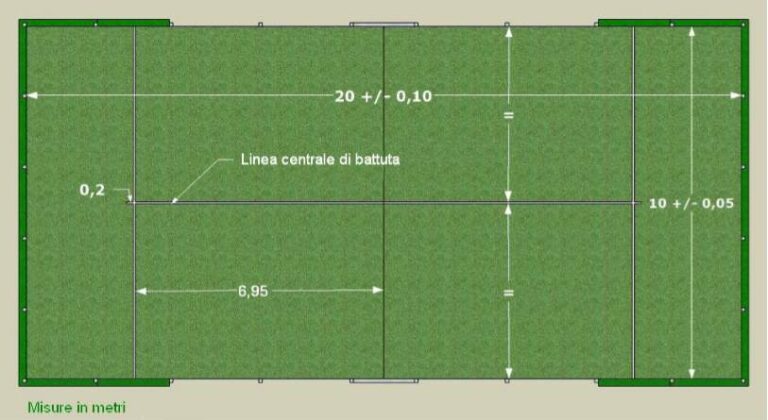
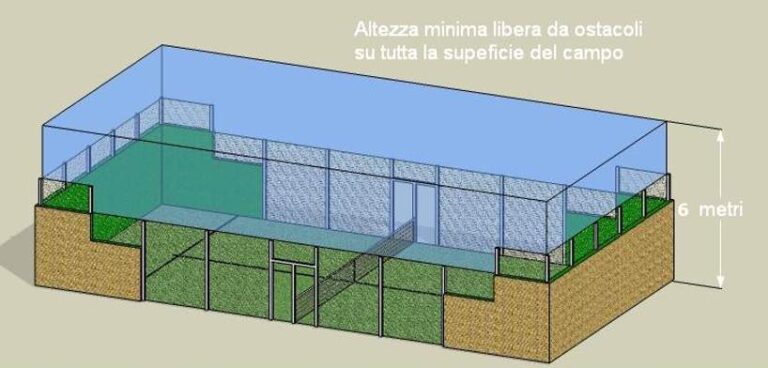
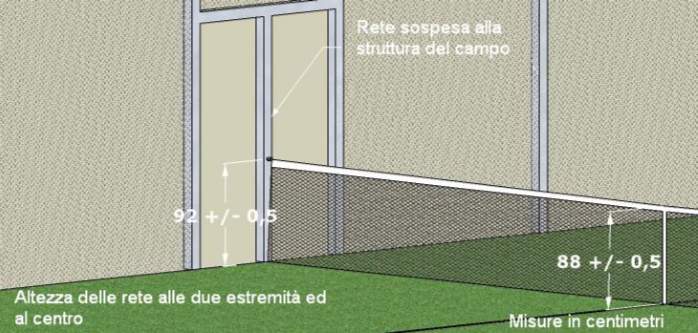
B) – The network ” 4

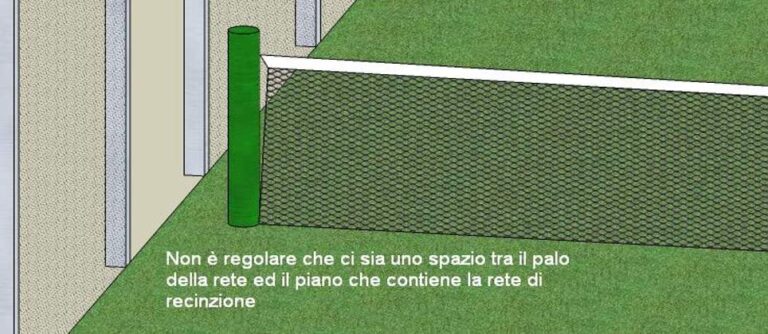
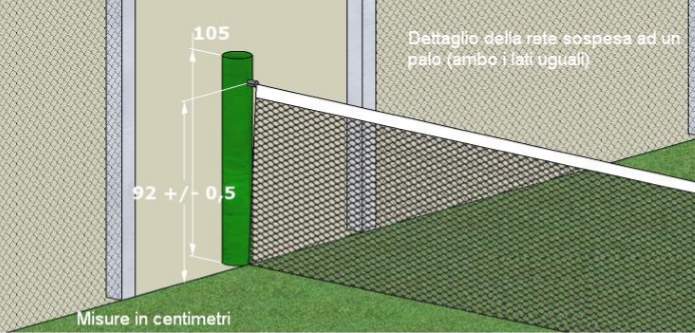
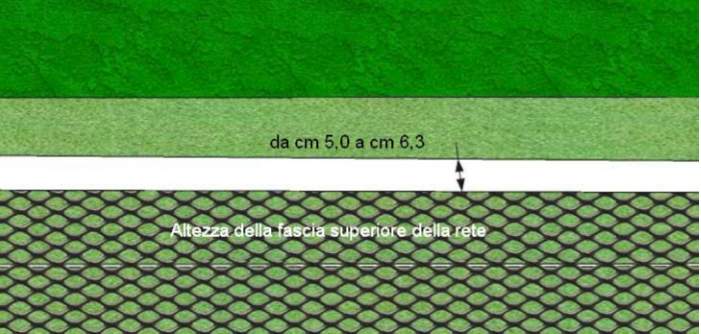
C) – The fences ” 6
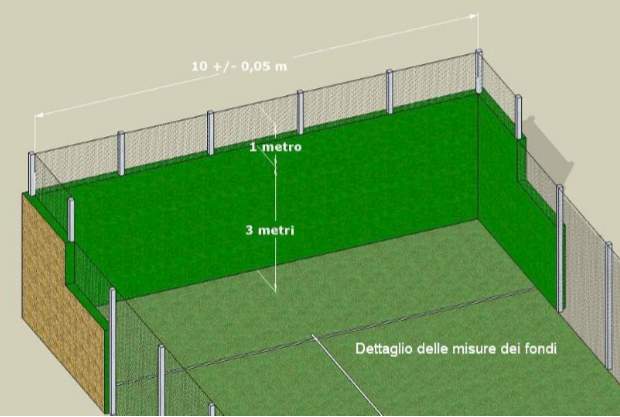

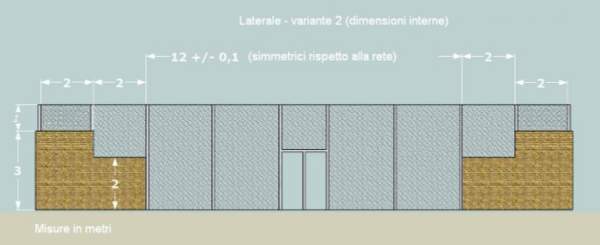
D) – The area ” 9
E) – Access ” 9
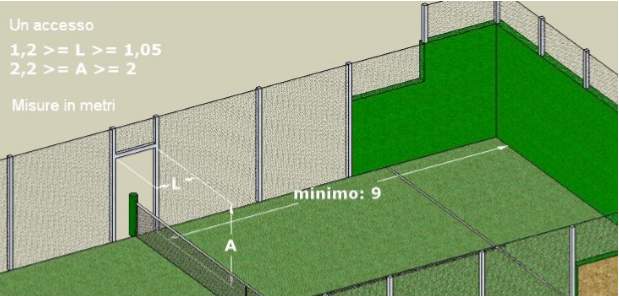

F) – Outdoor safety and play area ” 11
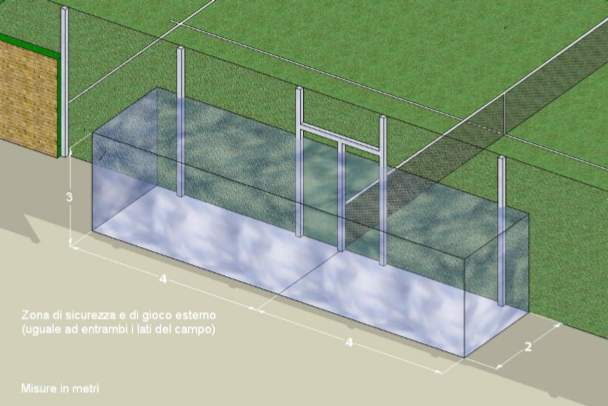
G) – Lighting ” 11
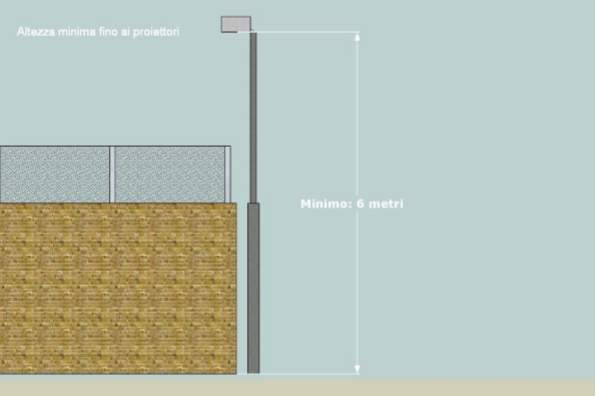
H) – Orientation ” 12
Title II – Equipment
I) – The ball ” 13
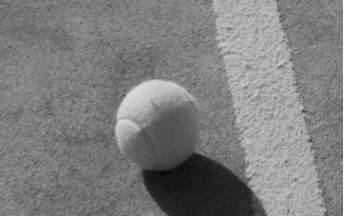
L) – The racket ” 13
Title III – The Game
Rule 1 – Score ” 15
Rule 2 – Timing ” 16
Rule 3 – Player Position ” 18
Rule 4 – Choice of courts side and bar ” 18
Rule 5 – Changing the courts side ” 18
Rule 6 – The bar ” 19
Rule 7 – Batting foul ” 20
Rule 8 – The Retort” 20
Rule 9 – Repetition of empty bar or bar ” 21
Rule 10 – Repetition of a point or null blow ” 22
Rule 11 – Disturbed blow ” 22
Rule 12 – Ball in play ” 22
Rule 13 – Lost point ” 23
Rule 14 – Good answer ” 24
Rule 15 – Point assigned ” 25
( 1 ) approved by the General Assembly of Calgary (Canada) of 26 August 2008, amended by the General Assembly of Seville (Spain) of 15 October 2009, with effect from 1 January 2010, and by the General Assembly of Riviera Maya of 30 November 2010, with effect from 1 January 2011.
2)
Rule 16 – Authorized outside play ” 25
Rule 17 – Change of balls ” 25
Title IV – Code of conduct
M) – Punctuality ” 26
N) – Clothing ” 26
O) – Identity ” 26
P) – Behaviour and discipline ” 26
PREMISE
The International Padel Federation (hereinafter referred to as FIP) is the governing body for the game of padel, and its tasks and responsibilities include establishing the rules of the game. The FIP Padel Rules Committee continuously monitors the game and its rules and proposes, when it deems it necessary, amendments to the Assembly, the responsible authority in the last instance to approve any modification of the Padel Rules, in accordance with Article 19 of the Staff Regulations.
NOTA: Unless otherwise stated, any prediction in the rules to the “player” refers to both sexes.
3
TITLE 1 – THE INSTALLATION (2)
A) The courts
1. The playing courts is a rectangle 10 m wide and 20 m long (internal measurements), with a tolerance of 0.5%.
( 2 ) All measurements are taken within the courts, but those relating to the height of the walls or the metal mesh, in the courtss with artificial grass, are made as if this were not there.
4
2.This rectangle shall be divided in half by a net on both sides of which, parallel to it and at a distance of 6,95 m, the two stop lines shall be drawn.
3. The space between the net and the stop lines shall be divided in half by a line perpendicular to them, called the centre stop line, dividing it into two equal zones and extending by 20 cm beyond the stop line.
4. The two halves of the courts shall be exactly symmetrical as regards the surface and the line marking.
5. All lines are 5 cm wide.
6. In covered courtss, the minimum clearance height up to the ceiling is 6 m over the entire surface of the courts and no furniture (e.g. lights) shall be placed in this space.
B) – The network
- The net shall be 10 m long and 0,88 m high in the centre and 0,92 m at the ends (with a maximum tolerance of 0,5 cm).
- The net shall be suspended from a metal cable with a maximum diameter of 1 cm, the ends of which shall be fixed to two lateral poles of a maximum height of 1,05 m or to the structure of the courts supporting and tensioning it.
- The cable tension device shall be designed so that it does not open unexpectedly and does not present a risk to players.
- The support posts of the net shall have an external face tangent to the lateral limits of the courts (opening, access or metal mesh) and may be of circular or square cross-section, provided that they have rounded edges.
- The net shall be attached to a white band, 5,0 to 6,3 cm high after folding, in which the net suspension cable slides. It may contain advertisements, provided that it is one colour.
- The net shall be mounted in such a way that the space between the support posts and the courts surface is fully filled, without being stretched, so that no space is left between the ends of the net and the posts.
- Its constituent meshes shall be of synthetic fibre and its width shall be small enough to prevent the ball from crossing the net.
Case 1: Can there be a gap between the wire fence or the floor that contains it and the mesh pole?
(v. figure)
Decision: No, such a playing courts is not regulated.
6
C) – The fences
2.The courts shall be fenced throughout, at the bottom by 10 m internal width and laterally by 20 m internal length, and in the fence combine areas built with materials that allow a regular rebound of the ball and areas of wire mesh where the zo rimbal is uneven, as described below.
2.On the short sides (bottom) the fence is a total of 4 m high, consisting of the first three metres from the wall and the last metre of wire mesh.
3. On the long (side) sides, two variants of the fence are allowed, as follows:
a) Variant 1 consists of wall-mounted scale zones at both ends, 3 m high and 2 m long for the initial angled section with the background opinion and 2 m high and 2 m high and 2 m high for the remainder, and areas of wire mesh that complete the fence up to 3 m high in the central 16 m and up to 4 m high in the final 2 m in each end;
b) Variant 2 consists of wall scale zones at both ends, 3 m high and 2 m long for initial laparte and 2 m high and 2 m long for the remaining part, and areas of wire mesh that complete the fence up to 4 m high throughout its extension.
4. The measurements indicated shall be calculated within the courts; the wire mesh shall always be aligned with the inner face of the wall.
5. Walls may be of any transparent or opaque material (crystal, bricks, etc.), provided that they have an adequate consistency for a smooth and uniform ball rebound. Any material used must have a uniform, hard and smooth surface, without any roughness, allowing contact, touching and sliding of the ball, hands and body.
The color of the opaque walls should be uniform and not interfere with the vision of the players or the conditions of the game.
6. For crystal-walled courtss, the rules for tempered glass shall be complied with:
a) for the European Union: EN 12150-1;
b) for other countries: see specific regulations.
Wire mesh shall be rhomboidal or square, simply twisted or electro-welded, provided that its dimensions (diagonal measurement) are not less than 5 cm or more than 7,08 cm. It is recommended that the diameter of the wire used is between 1,6 mm and 3 mm, with the possibility of reaching a maximum of 4 mm, having to maintain a tension that allows the ball to bounce.
8. If an electro-welded mesh is used, all welding points shall be protected both inside and outside the courts so that they do not cause cuts or scratches. If the electrosal- data network is mounted in square, non-rhomboidal shape, the horizontal wires parallel to the ground must be inside towards the courts and the vertical wires outside.
9. If the meshes are simply twisted, the tensors shall be placed outside the courts and always adequately protected. The joints or conjunctions between the rolls of the net should not have sharp elements.
10. Both electro-welded and twisted meshes must form a flat, vertex surface and must be maintained without losing these characteristics.
Case 2: If you continue with the same type of mesh to the top, beyond the regulatory limits (v. variants 1 and 2), in order to avoid the exit of the ball from the courts, it is recommended to place at the height of 3 or 4 m, depending on the case, a white stripe to clearly distinguish the part valid for the game from the invalid one. The ball hitting the white stripe is considered out of play.
D) – The surface
- The surface of the courts may be of porous conglomerate, cement, wood, synthetic matter or artificial grass or other materials, provided that the material allows the ball to bounce regularly and prevents water stagnation.
- The colour of the surface shall be green, blue or terracotta.
- The surface shall be so flat that the differences in internal levels are less than 3 mm on average, with measurements of 3 m (1/1000).
- The maximum transverse evacuation gradients shall be 1% in non-dainting areas and shall always start from the centre to the outside of the camp. Case 3: A gradient of 0% is valid on non-training surfaces.
- Synthetic or artificial turf floors must have the following characteristics:
a) for the European Union: compliant with UNE 41.958 IN specifications for sports floors;
b) for other countries: see specific regulations.
Requirements
Impact Absorption (Force Reduction)
RF 20%
Artificial grass
Clutch 0.4 0.8 Artificial grass
Vertical ball bounce 80%
Artificial grass
Synthetics
Sio 96%
Replacement of sand CaO 3%
Rounded edges
Granulometry: 80% by weight
16 mm – 1,25mm
Visible fiber length 2mm-3mm
Artificial grass
E) – Access points
1. The entrances to the courts shall be symmetrical with respect to its centre and shall be in the two side walls or in one. There may be one or two openings on each side, with or without a door (v. Rule 16 – Outside clearance).
2. If the entrances have no doors and if it is mounted above the ground, at the bottom of the access, any type of bar. metal or other material, for the reinforcement of the structure, must be understood as being part of the same in all respects; if such a bar is not there, the vertical area of the structure is considered to be inside the courts, even if there is no painted line above.
3. The dimensions of the openings shall be as follows:
a) with only one access per side: the opening has minimum dimensions of 1.05 x 2.00 m and the maximum dimensions of 1.20 x 2.20 (see figure);
b) with two entrances per side: each opening has a minimum size of 0.72 x 2.00 m and a mass of 0.82 x 2.20 m. (see figure).
Nota: Public facilities are subject to access and barrier-free regulations for people with reduced mobility.
4. The minimum distance between the back wall and the nearest side of the access shall be 9 m.
5. If there are doors, their handles shall be placed outside the courts so as not to cause any obstruction inside.
F – Safety zone and outdoor play area
1. Each side of the courts shall have two entrances. There shall be no physical obstruction outside the courts for a minimum space of 2 m width, 4 m length for each side and at least 3 m height. (see figure)
G – The lighting
1. Artificial lighting must be uniform and such that it does not impair the vision of players, referees and spectators. Must meet the standards:
a) for the European Union: EN 12193 “Lighting of sports facilities” and provide the following
minimum levels of illumination:
MINIMUM LEVELS OF ILLUMINATION
(external)
Horizontal lighting
E med (lux)
Uniformity
And min / E med
International and national competitions 500 0,7
Local competitions, training, school and recreational competitions 200 0,5
MINIMUM LEVELS OF ILLUMINATION
(internal)
Horizontal lighting
E med (lux)
Uniformity
And min / E med
International and national competitions 750 0,7
Local competitions, training, school and recreational competitions 300 0,5
b) for other countries: see specific regulations.
1. The light poles shall be placed outside the courts. If they are in the safety zone, outside clearance shall not be permitted.
2. The minimum distance in height from the ground to the bottom of the headlamps shall be 6 m.
3. For colour or cinematographic television, a level of vertical illumination of at least 1000 lux is required, although this value may increase with the distance of the camera from the subject. See the above standard for more information.
H) – Guidance
1. It is recommended that the longitudinal axis of the courts in outdoor installations be N-S, allowing for variability between N-NE and N-NO.
TITLE II – EQUIPMENT
I) – The ball (3)
1. The balls to be used in the official competition of the FIP shall be those approved by the FIP.
2. The ball is a rubber ball with a white or yellow outer surface. Its diameter varies between 6.35 and 6.77 cm and its weight between 56.0 and 59.4 g. It must have a rebound between 135 and 145 cm, if dropped on a hard surface from 2.54 m.
3. The ball shall have an internal pressure between 4,6 and 5,2 kg per 2,54 square centimetres.
4. When playing at more than 500 m altitude above sea level, another type of ball, identical to those already described, may be used, except for rebound, which must be between 121,92 and 135 cm.
L) – The racket
1. It shall be played with a regular padel racket, which shall conform to the following.
2. The racket consists of two parts: the head and the handle.
3. The handle has the following maximum sizes: length 20 cm, width 5 cm, thickness 5 cm.
4. The head shall vary in length but shall not exceed 45,5 cm in total when added to the head; its maximum width shall be 26 cm and its maximum thickness shall be 3,8 cm.
5. The total length of the racket, head plus handle, shall not exceed 45,5 cm.
6. A tolerance of 2.5% is allowed when checking the measures of the racket.
7. The stop surface in the central zone shall be punctured by an indefinite number of circular holes of 9 to 13 mm diameter each. Within the surface there can be a peripheral area of 4 cm, measured from the outer edge of the racket, where the holes can have different size and shape, as long as they do not change the essence of the game.
8. The stop surface, equal on both sides, shall be flat, smooth or wrinkled.
9. The racket shall be free from sticky objects or other devices other than those used solely to limit or prevent wear or vibration or to distribute weight.
Any object or device must have a reasonable size and a suitable location for its purpose.
( 3 ) NOTE FIT: All tests for the verification of ball requirements shall be carried out in accordance with the procedures laid down in international law or,
in the absence, from the national.
10. The racket must have a rope or non-elastic cord that connects it to the player’s wrist for accident protection. The rope, the use of which is compulsory, must have a maximum length of 35 cm.
11.The racket must be free from any device that is suitable for providing the player during the game with communications, advice or instructions of any kind, both visual and audible.
Caso 1: During the game, a player accidentally breaks the racket. Can he continue playing with the racket in such conditions?
Decision: Yes, unless it breaks the safety cord or the breakage makes the racket a dangerous object.
Case 2: Can the player use more than one racket during the game?
Decision: Yes, but the change cannot take place during the dispute of a point.
Case 3: Can the racket contain a stack (battery) that affects its playing characteristics?
Decision: No. A battery (battery) is prohibited The battery is prohibited because it is a source of energy, such as a solar cell or other similar devices.
TITOLO III – THE GAME
RULE 1 – Score in the game – Alternative scoring methods – Tie in the game
1. When a pair wins the first point, the score is 15; if it wins the second point, the score is 30; if it wins the third point, the score is 40 and with the fourth point won the game is won, except when both pairs have won three points and the score is “tie”; the following point is called “advantage” in favor of the winner and, if the same couple also wins the next point, he also wins the game; if he loses, he returns to “parity” and so on until one of the two pairs has won two consecutive points after the “tie”.
2. The pair that first wins 6 games, with at least two games to go, wins the game; in the event of a tie of 5 games, two more games must be played, until they win 7-5, but if there is a tie of 6 games, the tie-break takes place.
3. The matches are best played (a pair must win two matches to win the match).
4. In the case of a tie match, if it has been agreed beforehand, the third part may be played without tie-break in the case of a tie of six games (a tie of advantages), with the winner of two different games being awarded the tie.
The tie-break
5. During the tie-break, points are called “zero”, “1”, “2”, “3”, etc.
6. The tie-break is won by the pair who first wins 7 points, with two points of advantage over their opponents, thus winning the game and the match. If necessary, the tie break continues until this margin is reached.
7. In the tie-break, he starts to beat the player who would have had the right to beat, according to the sequence established in the match; he beats from the right side of the courts, only once; then, always respecting the above sequence, two points are played, starting to beat from the left side, and so on.
8. The tie-break winner wins the match 7-6.
9. In the following game, he begins to beat a player in the pair who began to argue in the tie-break.
Case 1: Who starts beating in the tie-break?
Decision: The player who started to beat at the beginning of the game, unless you check what is expected in the
Rule 6, letter J).
Alternative scoring methods
a) score in a game
Scoring method “without advantages” (gold point)
You can use this alternative scoring method: in a game the score is called as follows, starting with the batter: no point: “zero”
first point: “15”
second point: “30”
third point: “40”
fourth point: “game”
If both pairs have won three points each, the score is “tie” and you play a deciding point called “gold point”. The riveter pair chooses whether to answer from the left or right side of the courts. The members of the riveting couple cannot change position at the decisive point. The pair that wins the point wins the game.
In mixed doubles, the player of the same sex of the batter returns the deciding point, but the players of the riveter pair cannot change position to return that point.
b) score in a match (4)
Four game or “short game”
The pair that wins four games wins the game, as long as they have at least two games ahead of their opponents. If the pairs are on the score of four even games, you play the tie-break.
Decisive tie break at 7 points
When the score in a match is of an even match, a tie-break is played to decide the winner of the match. This decisive tie-break replaces the final game.
The pair that scores seven points wins the tie-break and the match, provided they have at least two points of advantage.
Decisive tie break at 10 points
When the score in a match is of an even match, a tie-break is played to decide the winner of the match. This decisive tie-break replaces the final game.
The ten-point winning pair wins the tie-break and the match, provided they have at least two points of advantage.
Note 1: When the decisive tie-break is played instead of the final game, the original spin of the beat is continued, but each pair can change the order of the batters and the positions of the riveters.
Note 2: The balls did not change at the beginning of the tie break, even if it is expected.
RULE 2 – Timing
1.The Referee declares the loser of the match (WO) a pair whose players are not on the courts ready to play within ten minutes of the time set for the start, except when the referee assesses that it is a case of force majeure.
( 4 ) NOTE FIT: In national competitions only, as long as it is indicated in the tournament rules program, exceptionally the match can be played with a “long game” to 9 games, with tie-break dispute on the score of 8 even games.
Case 1: If the scheduling of the schedules takes place in shifts (to follow), the scheduled time for the start of the meeting is fixed five minutes after the end of the previous meeting.
2. The preliminary dribble shall last five minutes and shall be obligatory.
3. As a rule, the game must be continuous, from the moment the match begins (when the first bar is made) until it ends and must never be suspended or postponed to the stage allow a player to regain strength or receive instructions or advice. (5)
4. Between one point and the next the maximum allowable interval shall be 20 seconds.
5. When players change sides of the courts at the end of a game, a maximum interval of ninety seconds is allowed. After the first game of each game and during the tie-break the game is continuous and players change sides of the courts without interval.
6. A maximum interval of 120 seconds shall be allowed at the end of each batch.
7. The time of these intervals shall begin at the time a point is assigned and end when the next stop is made.
8. If, due to circumstances beyond the control of the player, the player’s clothing, footwear or equipment breaks or needs to be replaced, the player shall be given a reasonable additional time to resolve the problem.
9. If notified before the meeting, a limited number of intervals for going to the bathroom or changing clothing may be allowed.
10. Twenty seconds are allowed for the courts side change during the tie break.
11. If a match is to be suspended for reasons independent of the players (rain, darkness, accident, etc.) on resumption of the match the pairs are entitled to a preliminary dribble as follows:
a) up to five minutes suspension, no preliminary dribble;
b) 6 to 20 minutes suspension, three minutes of preliminary dribbling;
c) more than 21 minutes suspension, five minutes preliminary dribbling.
12. The match must resume exactly where it was interrupted, that is, with the same game and score, with the same player at the bar, with the same disposition on the courts and with the same sequence of beats and retorts.
13. If the suspension is due to darkness, the match must be interrupted when the sum of the games in the current match is equal, so that on the second half both pairs are placed on the same side as when the interruption occurred. (6)
14. If a player is injured or suffering from a treatable medical condition, they are allowed three minutes of sigh for treatment, which can be repeated in the two subsequent courts side changes, but always within the maximum regulatory time. If the suspension occurs during a change of courts side, the player can receive medical assistance within such a suspension that can last three minutes, being able to be repeated in the following two changes of courts side, but always in the maximum regulatory time.
( 5 ) NOTE FIT: Time violations during the game are subject to the penalties set out in the Code of Conduct.
( 6 ) NOTE FIT: The Arbitrator must communicate the suspension to the Arbitrator Judge, who sets the time for the resumption of the match on the same day or in the
next day; in the meantime the Referee and the players must remain at the disposal of the Referee Judge, until his decision.
18
15. Assistance may be provided only once for each player and this right may not be transferred to the partner. 16. In the event of an accident which is not a direct consequence of the game and which affects one of the players, the Judge may, in his opinion, grant a time for assistance, which in no case exceeds 15 minutes.
17. If a player has a bleeding wound, he cannot continue the game.
Case 1: If the incident is not a direct consequence of the game, does the player’s assistance count?
Decision: No, it doesn’t count.
Case 2: What rest and break time can you have between the first and the second bar?
Decision: No one, the game must be continuous.
RULE 3 – Position of players
1. Each pair of players is arranged in each half courts, placed on either side of the net. The player who puts the ball into play is the batter and the one who pushes it back is the riveter.
2. The riveter may be placed anywhere on his side of the courts, as well as his partner and the batter’s companion.
Case 1: Can a player stand outside the playing courts while making the bat?
Decision: No, you can’t.
Case 2: Is a player of one pair allowed to play alone against opponents?
Decision: Yes, if the teammate stays on the courts and beats and responds when it’s his turn.
RULE 4 – Choice of courts side and bar
1. The choice of the side of the courts and of the right to be batter or riveter in the first game shall be by draw.
2. The winning pair may choose:
a) to strike or to strike, in which case the other pair chooses the side of the courts; or
b) the side of the courts, in which case the other pair chooses to strike or to strike back; or
c) to leave the first choice to the opponents.
3. After deciding the batting order and the side of the courts, both pairs shall inform the referee who are the first batter and the first riveter.
Case 1: Are both pairs entitled to make a new choice if the preliminary dribble is interrupted and the players leave the courts?
Decision: Yes. The result of the initial draw remains valid, but both pairs can make new choices.
RULE 5 – Changing the courts side
- Pairs change sides of the courts when the sum of the games played in each match is odd.
- In the tie break, players change sides of the courts every six points.
- If you make a mistake and do not change sides, players correct it as soon as it is discovered, continuing with the correct sequence. All points made before the error was discovered are valid. If the error is discovered when you have only done a batting foul, you are only entitled to the second bar.
Case 1: At the end of a game you have a rest of 120 seconds. To start the next game, you have to change the side of the courts?
Decision: Yes, if the sum of the games of the finished game is odd; no, if the sum is even.
Case 2: At the end of the first game of each match, you must change the pitch. Are you entitled to a rest?
Decision: No, there is no rest.
RULE 6 – The bar
- All points start with the bar. If the first bar is foul, you have a second chance.
The beating shall be as follows:
a) the batter, at the beginning of the batting, must stand with both feet behind the batting line, between the imaginary extension of the central batting line and the side wall (batting area) and must maintain this position until the ball is hit; (v. figure)
b) the batter must bounce the ball on the ground of the batting area in which it is located; (7)
c) the batter must not touch the bar line or the imaginary extension of the centre line with his feet;
d) when hitting the ball for the bat, it must be at the height of the belt or lower and the player must keep at least one foot in contact with the ground;
e) the batter must throw the ball over the net, in the box opposite diagonally in the other side of the courts, so that the first bounce takes place in that box or on one of the lines that surround it; the first bar is made from the right side towards the square to its left and, at the end of the point, the following is made from the left side towards the square to its side, then continuing alternately from the two sides;
f) the batter cannot walk, run or jump when making the shot; it is believed that the thug did not change position if he made small movements with his feet that did not change the initial position;
g) at the moment of the impact with the ball or of the failed attempt to hit it, the bat is considered to be carried out;
h) if the bat is made by mistake from the wrong side of the courts, the error of position must be corrected immediately; all the points made are valid, as well as counting a typo committed before the discovery of the error;
i) the pair that has the right to beat in the first game of each game chooses which of the two partners starts beating; in turn, at the end of the first game, the returner pair becomes the batter and chooses the player who beats first and so alternately for all games of the match; established the batting order, this cannot be changed until the beginning of the next match;
( 7 ) NOTE FIT: A player without the use of an arm can throw the ball for rebound with the racket.
j) if a player beats out of turn, he who had to beat must do so as soon as he discovered the error; all the points made before discovering the error are valid, but if there was only one batting foul before discovering the error, this does not count; if the game ended, the batting order is thus altered until the end of the match;
k) the batter does not have to hit if the riveter is not ready. However, the riveter must adjust to the reasonable beat of the batter and must be ready to strike when the batter is ready to strike;
l) you cannot claim that you were not ready to respond if you tried to do so. If you- show that the riveter was not ready, it cannot be called the batting foul.
Case 1: At what maximum height can a player hit the ball, if he flexes his legs at the time of batting?
Decision: To the one where, at that moment, the belt is located or below this.
RULE 7 – Batting foul (8)
1. The joke is foul if:
a) the batter violates the provisions of Rule 6 – The bar, letters a) to f);
b) the batter completely misses the ball in an attempt to hit it;
c) the batting ball falls out of the kicker’s batting area, which also includes lines that delimit it (the lines are part of the courts);
d) the batting ball hits the batter, his partner or any object they wear or wear;
( 8 ) NOTE FIT: If the batting ball bounces twice in the batting area of the opposing courts or on the lines that delimit it, before hitting the walls or the fence or the racket of the riveter, the batting is correct and the point is assigned to the batter.
e) the batting ball bounces in the batting area of the opposing courts and hits the metal net that delimits the courts before the second rebound;
f) the batting ball bounces into the batting area of the opposing courts and comes out directly from the goal in a courts without a safety zone and for playing outside.
Case 1: The beaten ball, before bouncing for the first time on the ground, touches one of the walls or the wire mesh or a light in the batter’s courts, but passes the net and falls into the court’s batting area
opponent. Is the service valid?
Decision: No, it’s foul.
Case 2: The bat is a lob and the ball after bouncing in the batting area of the opponent’s courts, comes directly out of the courts beyond the metal fence. Is it foul?
RULE 8 – The reverse
1. The riveter must wait for the ball to fall into its batting area and must return it before the second rebound.
2. The returner pair in the first game of each match decides which of the two players begins to retch and that player continues to retype the first bar of each game in which the pair is returner, until the end of the game.
3. Each player returns alternately during the game and the chosen order cannot be changed during the game or tie-break, but only at the beginning of the next game.
4. If during a game or tie-break, the order of retching is altered for the returning pair, it shall be continued in this way until the end of the game in which the error occurred; in the following rounds of the game, The riveting couple takes the position chosen at the beginning of the same.
5. If the riveter or his partner hits the ball or touches it with the racket before the rebound, the point is assigned to the batter.
Case 1: In the case of courtss of old construction with vertical edges at the point of union between the wall and the metal fence, ie the wall and the fence are not in the same plane, when the ball hits the corner or the edge, the batting is valid only if, after having bounced and hit that edge, it continues obliquely towards the riveter, beyond the imaginary line that runs from that edge to the opposite one. (v. the figure).
Case 2: If the ball bounces twice in a row in the knock area of the rebounder, even if it hit the wall between the two rebounds, the batting is point for the batter.
Case 3: The riveter cannot hit the ball on the fly even if he does it outside the service area.
RULE 9 – Repetition of blank bar or bar
1. The bar is repeated (blank) if:
a) the ball touches the net or the poles that support it (if they are inside the courts) and then falls into the knock area of the riveter, provided that it does not touch the wire mesh before the second rebound;
b) the ball, after touching the net or the poles (if placed inside the playing area), hits one of the opponent or whatever he is wearing or wearing;
c) is carried out when the riveter was not ready (Rule 6/k).
2. If the first bar is empty, it shall be repeated; if the second bar is empty, the batter shall be entitled to repeat only this second bar.
Case 1: The ball in play touches the net and bounces for the first time in the correct area and for the
second time, coming out the door, off the courts. Is the joke nothing or is it foul?
Decision: If you can play the ball off the courts, you beat nothing; otherwise it is foul.
RULE 10 – Repetition of a point or null blow
1. A stroke is considered null (and repeated) if:
a) the ball breaks during the game;
b) an element unrelated to the ongoing meeting invades the courts;
c) in general, the game is interrupted by any unforeseen situation outside the control of the players.
2. A player who during the game considers that a situation has occurred which the rules consider to be a “null blow”, shall notify the referee immediately and shall not continue the game, otherwise he loses the right to request it later.
After the request of the “null blow”, it is up to the arbitrator to determine whether it is correct, otherwise the applicant loses the point.
Case 1: If you committed a foul in the first bar and started the point with the second bar, what happens if during this point a “null blow” is called?
Decision: The point is repeated with right to the two bars.
REGOLA 11 – Disturbed blow
1. A disturbed blow is considered when a player commits an act, deliberately or unintentionally, that disturbs an opponent in the execution of a blow; the referee
a) in the first case, assign the point to the opponent and
b) in the second case, it orders the point to be repeated (null shot), if the player who has been disqualified has won it.
RULE 12 – Ball in play
1. The ball shall be hit alternately by each of the two opposing pairs.
2. The ball is in play from the moment a valid hit is made and remains in play until it is called a “null hit” or the point is awarded.
3. If the ball in play hits any element of the courts after bouncing off the correct playing courts, it shall remain in play and be delayed before it touches the ground for the second time
4. Elements of the courts shall be considered to be the inner face of the walls, the metal mesh surrounding the courts, the ground, the net and its support poles. The frame, which defines the welded mesh, is considered in all respects as a metal mesh.
RULE 13 – Lost point
1. A pair loses the point:
a) if, while the ball is in play, a member of the pair, his racquet or whatever he is wearing or wearing touches any part of the net, including the poles supporting it, or the land of the opposing courts, including the wire mesh;
1) Outside authorized play. Above 0.92 m from the ground and only if outside play is allowed, the vertical median pole between the doors is considered a neutral zone, so the four players can touch or cling to it;
b) if the ball bounces for the second time before being rejected;
c) if the ball, after having bounced correctly on the ground, leaves the courts (bottom or side) above the upper limits (outer perimeter) or from the goal;
1) Outside play allowed. When the ball, after properly bouncing in the ground, comes out of the upper limit of the bottom wall. If it exits the upper limit of the side wall or the door, the point is lost when it bounces off the ground for the second time or touches an external element outside the courts;
d) if it postpones the volleyball before it has crossed the net;
e) if a player sends back the ball, either directly or first hitting the walls of his half of the courts so as to hit, without making it bounce before, a wall of the opposing courts, the metal net or any foreign object on the opponent’s courts;
f) if a player sends the ball back, either directly or by first hitting the walls of his half of the courts so as to hit the net or the support poles and then directly a wall of the opposing courts or the wire mesh or any foreign object that is not in the opponent’s courts; (9)
g) if a player hits the ball twice in a row (double shot);
h) if, after one of the pair has hit the ball, it touches the player who hit it or his partner or whatever they wear or wear;
i) if the ball touches one of the members of the pair or its equipment, except the tag, after being hit by one of the opponents;
j) if a player hits the ball and it touches the wire mesh or the ground in its half of the courts or any foreign object on the pitch;
k) if he hits the ball against the racket;
l) if he jumps over the net while the ball is in play;
m) only one player at a time can hit the ball to repel it; if both players in the pair, or simultaneously or consecutively, hit the ball, they lose the point.
NOTE: It is not considered a double shot when the two players try to hit the ball but only one hits it, while the other hits the racket of the partner.
n) if the player hits the ball in the courts with one or two feet off the playing courts, unless “outside play” is authorized.
o) the player commits a foul in the second bar.
Case 1: If the ball, after having bounced in the courts correctly, does not leave the courts because it hits the additional fence placed in some cases above the regulatory wire mesh, what is the decision?
Decision: The point is lost.
RULE 14 – Good answer
( 9 ) NOTE FIT: Similarly if the ball hits the lighting projectors or the ceiling of the covered courts, before bouncing into the courts
opponent.
1. The answer is good:
a) if the ball, after being hit, is hit on the fly by one of the players of the opposite pair or touches his body and any part of his clothing or his racket;
b) if the ball, after being hit, bounces directly into the opponent’s courts or first hits one of the walls of his courts and then bounces directly into the opponent’s courts;
c) if the ball bounces into the opponent’s courts and then touches the wire mesh or one of the walls;
d) if, as a result of the direction and force of the blow, the ball bounces into the courts and then comes out of the limits of the courts or hits the ceiling or lights of the lighting or whatever object or furniture of the courts;
e) if the ball touches the net or the support poles and then bounces into the opponent’s courts;
f) if the ball in play hits any object outside the game (for example, another ball) located in the opponent’s courts;
g) if the ball, after rebounding in the correct courts, returns to the court of the person who hit it and is hit in the opponent’s courts, provided the player or any part of his clothing or racket has not touched the net, the support poles or the opposing courts is the ball is in accordance with points a) to f) above;
h) if the ball is held or accompanied, the response is good if the player has not hit the ball twice, the shot is made with a single movement and the natural trajectory of the ball has not changed substantially;
RULE 15 – Assigned point
1. The points shall be assigned to the person who hit the ball:
a) if the ball, after rebounding in the opposing courts, exits the courts through a hole or a defect in the metal fence or gets stuck in it;
b) if the ball, after rebounding in the opponent’s courts, stops in the upper horizontal surface of the wall.
RULE 16 – Authorized outside play
1. Players may exit the courts and from outside hit the ball provided that the courts complies with the requirements set out in paragraph F) – Security zone and outside play.
RULE 17 – Change of balls
1. The organisers of the event must give advance notice of:
a) the make and model of the balls to be used;
b) the number of balls to be used in the game (2 or 3);
c) change of balls, if provided.
1. Change of balls, if provided, may be done by one of the following methods in each match:
a) after a certain odd number of games. The preliminary dribble counts as two rounds and the tie-break as one, at the end of the change of the balls; the change of the balls cannot be done at the beginning of the tie-break; in this case, the change of the balls is postponed to the beginning of the second game of the next game;
b) at the beginning of the game.
3. In cases where the balls have to change after a certain number of games and this does not happen in the right sequence, the error is corrected when he has to beat again the pair that had to do it with new balls, before the error occurred. After that, the balls are rotated so that the number of games for the change of the balls is the original one.
4. When a ball is lost, broken or, for any other reason, deteriorates so that it is different from the others, the referee shall order that it be replaced by another of the same conditions as the others remaining in play. If not possible, all balls must be changed. (10) To start the point, you must have at least two balls.
( 10 ) NOTE FIT: The change of the balls, whether expected or required by the circumstances of the game, is ordered only by the Referee or the Referee.
TITLE IV – CODE OF CONDUCT
M) – Punctuality
1. Meetings shall start without delay at the scheduled time. The schedule of the matches must be published well in advance, being the obligation of the player to inform of the same.
2. The order of the game may not be changed without the permission of the arbitrator.
N) – Clothing
1. The player must present himself to play with appropriate sportswear and footwear, as the use of sleeveless T-shirts or swimsuits is not permitted. Otherwise, the warned player must replace it with regular clothing or is disqualified.
2. In team competitions, it is recommended that players wear identical clothing, even if this is not mandatory.
3. Players may use the footwear, clothing and rackets they wish, provided that they are regulated.
4. In international tournaments, the arbitration panel shall wear clothing to enable it to be identified.
O) – Identity 1. The participants in the competition must prove, at the request of the Judge, their identity, nationality, age and in general any other requirement directly connected with the competition, by submitting the appropriate documents.
P) – Conduct and discipline
1. All players shall behave in a courteous and polite manner throughout their stay in the competition, even if they are not participating, and respect any person they encounter in the competition.
2. Coaches, like players, shall behave appropriately, taking into account that the penalties which the arbitrators may impose on them in the match are in addition to those which may be awarded to the players.
8. Visible obscenities are signs or gestures made with hands or with rackets or balls, which commonly have an obscene or reasonably offensive meaning to people.
9. Ball abuse: Players can never violently throw, in any direction, a ball outside the courts or hit it violently towards the other side of the net while not in play.
10. Racket or equipment abuse: Players may never intentionally throw the racket or throw it violently against the ground or against the net, referee’s chair, walls, metal fence, or any other courts furniture.
11. Verbal abuse and physical abuse or aggression: these are the aggressive or anti-sportive behaviour, attitudes and gestures of the players, which have a particular gravity when they are addressed to the referee, the referee, the opponents, to the partner, the spectators or any person connected to the tournament. Verbal abuse is considered to be the insult, as well as any oral expression that, without being considered an insult, intrinsically has a value of contempt or discrimination towards others.
12. Maximum effort. All players must make every effort to win the match in which they are participating.
13. Unsportsmanlike conduct. Players must at all times behave in a correct way, avoiding any action that is contrary to the sporting spirit or the competition or, in general, to the respect of the established rules or the correct game
14. Penalties – Penalty table. For infringements, during the course of the meeting, of any provision above, the Judge arbitrator of the event shall apply the sanctions indicated in the Table of penalties below. Independently from this, the organs of the sporting justice can impose other possible sanctions for the same fact, in application of the provisions of the Regulation of justice.
15. Table of penalties:
a) first infringement: warning;
b) second warning infringement with point loss;
c) third infringement: brought to an end by disqualification.
16. Infringements committed by the members of the couple and their authorised technician may be committed.
17. Direct disqualification. In case of very serious infringement (physical assault or very serious verbal) the Judge can order the immediate disqualification of the player or the coach who committed it. If the disqualification affects a player who is playing a match, the match is lost and the player must leave the event. If he hits a technician, captain or player credited or registered to the current competition, the disqualified must leave the event.
Daniele Cattaneo and Simone Cremona win the Italian championship
Our fierce testimonials Daniele Cattaneo and Simone Cremona won the absolute Italian championships in Padel, beating Michele Bruno and Luca Mazzetti in the final on September 2 in Riccione.

